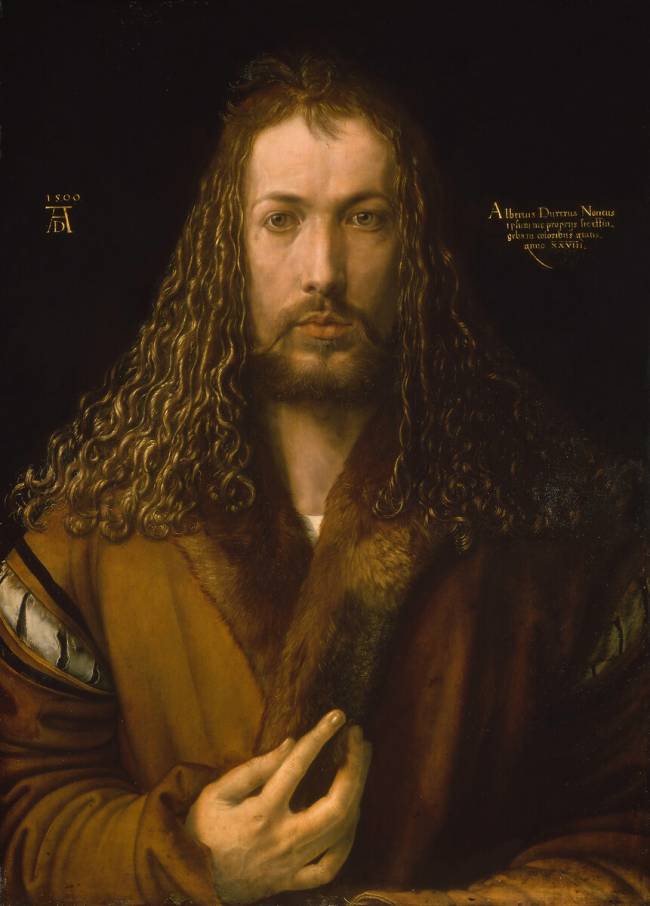Shop art print and framed art Self-portrait by Albrecht Dürer
Customise
Your art print
Self-portrait OF Albrecht Dürer

Self-portrait
Dürer's self-portrait: image of a teeming historical and artistic context
This self-portrait is part of a pivotal period in European history, marked by the intellectual and artistic effervescence of the Renaissance. Humanism, which placed man at the center of all concerns, was then developing in Northern Europe. Albrecht Dürer, the emblematic figure of the German Renaissance, deeply influenced by these new ideas, produced this self-portrait on his return from Italy, where he had been inspired by the masters of the Italian Renaissance. By then, he was a recognized artist, having already produced numerous engravings and paintings that had earned him a certain notoriety. This picture, painted in 1500 and now housed in Munich's Alte Pinakothek, marks a milestone in his career, affirming his technical mastery and artistic ambition. It also testifies to the changing status of the artist during this period, as he gradually moved from artisan to creator.
A self-portrait with a frontal, hieratic composition
The work is striking for its frontal composition and hieratic character. Dürer depicts himself in bust form, his gaze fixed and intense, directed at the viewer. His face, framed by long, wavy hair and a full beard, occupies most of the composition. He is dressed in an elegant fur-collared coat, and the light, coming from his right, shapes the volumes of the face and accentuates the contrast between light and shadow, creating a striking relief effect. The dark, neutral background highlights the main subject and reinforces the impression of solemnity that emanates from the work.
Dürer's Self-Portrait: a divine look at the artist
In his self-portrait, originally named Self-portrait at twenty-eight, wearing a coat with fur collar, Dürer here presents himself in an idealized, almost divine light. The symmetry of the composition, the frontality of the figure and his fixed gaze evoke traditional representations of Christ. This analogy is reinforced by the position of his hand, which sketches a gesture that echoes the codes of blessing in religious works. The artist thus asserts himself as a creator in the image of God, capable of giving life to matter. He places himself at the center of his own creation, thus claiming the nobility of his art and its essential role in society.
Dürer's Self-portrait: a work with multiple readings
This oil on wood, measuring 66.3×49 cm, invites us to plunge into the heart of the artist's soul and decipher the multiple symbols that make it up. The long hair and beard, attributes traditionally associated with Christ, underline the spiritual dimension of the work, as do the position of his hand, his fixed gaze and the frontal composition, usually reserved for religious representations (portraits were generally three-quarter or in profile at the time). With his desire to leave a lasting mark on history, Dürer clearly wished to imitate Jesus Christ, taking on all his codes.
Among other points to highlight, the fur, a symbol of wealth and power, testifies to the artist's social success. Small inscriptions can also be seen on either side of the subject, leaving no doubt as to the painting's origin, with the initials "AD" present, and on the other side, an inscription meaning "I, Albrecht Dürer of Nuremberg, painted my portrait in this way at the age of 28 with imperishable colors".
Dürer's Self-portrait A major artistic legacy
Dürer's Self-portrait has had a considerable impact on art history. It helped to raise the status of self-portraiture and portraiture, by integrating a major religious element into the representation of the subject. Many artists, after Dürer, were inspired by this work to create their own self-portraits, or to paint famous figures, using the codes of this painting.
This painting also bears witness to Dürer's exceptional technical mastery, particularly in the rendering of textures and details. Today, it remains one of the artist's most famous works, and a must-have reference for all art lovers.
This artwork is a painting from the renaissance period. It belongs to the flemish & northern renaissance style.
« Self-portrait » is kept at Alte Pinakothek, Munich, Germany.
You may also like
- 30% !
Make good deals by browsing our Reserve : editions of our catalog which await their purchaser at a low price.























